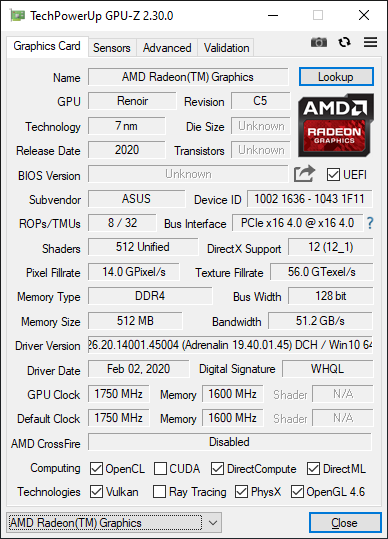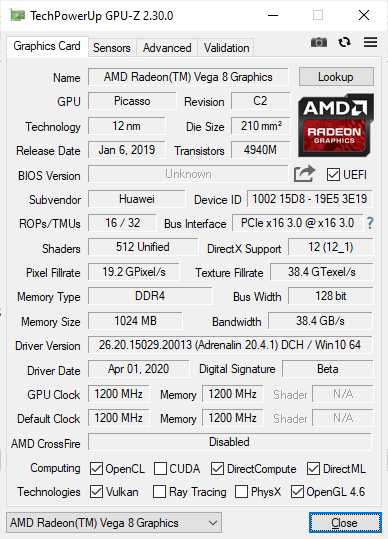AMD’s Mobile Revival: Redefining the Notebook Business with the Ryzen 9 4900HS (A Review)
by Dr. Ian Cutress on April 9, 2020 9:00 AM ESTTesting the Ryzen 9 4900HS Integrated Graphics
Under the hood of the Ryzen 9 4900HS, aside from the eight Zen 2 cores, is an enhanced Vega 8 graphics solution. For this generation of mobile processors, AMD is keeping the top number of compute units to 8, whereas in the previous generation it went up to Vega 11. Just by the name, one would assume that AMD has lowered the performance of the integrated graphics. This is not the case.
For the new Ryzen Mobile 4000 processors, the Vega graphics here are enhanced in three main ways over the previous generation. First is that it is built on the 7nm process node, and AMD put a lot of effort into physical design, allowing for a more optimized version that has a wider voltage/frequency window compared to the previous generation. Secondly, and somewhat connected, is the frequency: the new processors top out at 1750 MHz, rather than 1400 MHz, which would naturally give a simple 25 % boost with all other things being equal. Third on the list is memory, as the new platform supports up to DDR4-3200, rather than DDR4-2400, providing an immediate bandwidth boost which is what integrated graphics loves. There’s also the nature of the CPU cores themselves, having larger L3 caches, which often improves integrated graphics workloads that interact a lot with the CPU.
Normally, with the ASUS Zephryus G14, the switching between the integrated graphics and the discrete graphics should be automatic. There is a setting in the NVIDIA Control Panel to let the system auto-switch between integrated and discrete, and we would expect the system to be on the IGP when off the wall power, but on the discrete card when gaming (note, we had issues in our battery life test where the discrete card was on, but ASUS couldn’t reproduce the issue). In order to force the integrated graphics for our testing, because the NVIDIA Control Panel didn’t seem to catch all of our tests to force them onto the integrated graphics, we went into the device manager and actually disabled the NVIDIA graphics.
This left us with AMD’s best integrated graphics in its Ryzen Mobile 4000 series: 1750 MHz of enhanced Vega 8 running at DDR4-3200.

Renoir with Vega 8 – updated to 20.4 after this screenshot was taken
Our comparison point here is actually a fairly tricky one to set up. Unfortunately we do not have a Ryzen 7 3750H from the previous generation for comparison, but we do have an Honor Magicbook 14, which has a Ryzen 5 3500U.
This is a 15 W processor, running at 1200 MHz and DDR4-2400, which again makes the comparison a little tricky, but it is better than comparing it to the Intel HD630 graphics in the Razer Blade.
We also re-ran the benchmarks on the latest drivers with AMD's 65 Desktop APUs, the Ryzen 5 3400G (with Vega11) and the Ryzen 3 3200G (with Vega 8). These are running at DDR4-2933, the AMD maximum officially supported by these APUs (which means anything above this is overclocking).


This is a pretty substantial difference, no joke.



Hopefully we will get more variants of the Ryzen integrated graphics to test, along with an Ice Lake system.











267 Comments
View All Comments
ingwe - Thursday, April 9, 2020 - link
This is very exciting! Especially those battery life numbers.shabby - Thursday, April 9, 2020 - link
Wow ya i was hoping it would at least match intel not double intels battery life lolBigMamaInHouse - Thursday, April 9, 2020 - link
CB R20 Scores are wrong Again :-)Cooe - Thursday, April 9, 2020 - link
The scores are right, they are just labeled wrong lol.SolarBear28 - Thursday, April 9, 2020 - link
@IanCutress The scores should be reversedSamus - Friday, April 10, 2020 - link
It isn't just exciting. It's shocking. AMD finally has a viable notebook CPU.Now they need to come up with something worthy against the U series for ultraportables because the current crop Ryzen U parts (like the Pro 3500U) are a tough pill to swallow since they seem to run closer to 35w under any sort of load.
Gondalf - Friday, April 10, 2020 - link
Here i can see only and AMD 8 cores SKU beating a 6 cores one. There is nothing to be shocked.Try a 8 cores Intel laptop instead, equipped with a new intel SKU and not with one shipped one year ago.
Qasar - Friday, April 10, 2020 - link
and what if the 8 core intel laptop couldnt compete with this one, then what ? would you find a way to make up some lame BS reason as to why it still lost??? come one gondalf, get a lifeGondalf - Sunday, April 12, 2020 - link
Pretty pointless to compare a 6 core cpu with a 8 core one.Moreover the article is rushed because Intel SKUs have a 15ms delay to go from idle to max turbo.
Very likely the Intel Laptop suffer of bad settings or wrong/obsolete bios. Same applies to power measures, with a 80Wh battery an Intel laptop can last around 10 hours browsing web with GPU down. My 38Wh battery give me 5 hours of the same workload, with GPU down.
My bet Intel laptop was with GPU up under the test.
So better wait less rushed reviews to judge.
Qasar - Sunday, April 12, 2020 - link
pretty pointless to try everything you can do to give intel excuses as to why they are losing gondalf, even if intel had more cores, they would still be losing, i believe zen 2 desktop vs intels desktop cpus show this, more cores for intel, and intel still looses on most tests, but yet if it was the other way around, it would be ok, and you would just bash amd for making an inferior product. either way, your just trying to come up with lame BS as to why intel lost, like most i bet, knew you would. very likely, intel just has the inferior product right now.